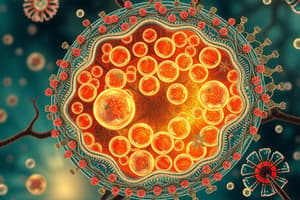Podcast
Questions and Answers
What is the thickness of the phospholipid bilayer in the cell membrane?
What is the thickness of the phospholipid bilayer in the cell membrane?
- 5-7 nanometers (nm)
- 15-20 nanometers (nm)
- 10-15 nanometers (nm)
- 7-10 nanometers (nm) (correct)
What is the function of the cell membrane in regulating what enters and leaves the cell?
What is the function of the cell membrane in regulating what enters and leaves the cell?
- Providing mechanical support
- Generating energy for the cell
- Regulating transport of molecules (correct)
- Maintaining cell shape
What type of molecules make up the majority of the phospholipid bilayer?
What type of molecules make up the majority of the phospholipid bilayer?
- Carbohydrates
- Phospholipids (correct)
- Cholesterol
- Proteins
What is the term for the movement of molecules from high to low concentration without energy input?
What is the term for the movement of molecules from high to low concentration without energy input?
What is the name of the model that describes the cell membrane as a dynamic, fluid structure?
What is the name of the model that describes the cell membrane as a dynamic, fluid structure?
What is the function of cholesterol in the cell membrane?
What is the function of cholesterol in the cell membrane?
Flashcards are hidden until you start studying
Study Notes
Cell Membrane Structure
- Phospholipid bilayer: composed of two layers of phospholipid molecules with their hydrophobic (non-polar) tails facing inward and hydrophilic (polar) heads facing outward
- Thickness: approximately 7-10 nanometers (nm)
- Semipermeable: allows certain molecules to pass through while keeping others out
Cell Membrane Functions
- Regulates what enters and leaves the cell
- Maintains cell shape and provides mechanical support
- Acts as a barrier against external substances
- Plays a role in cell signaling and communication
Cell Membrane Components
- Phospholipids: amphipathic molecules that make up the majority of the bilayer
- Proteins: embedded in the bilayer, facilitate transport, signaling, and cell-cell interactions
- Cholesterol: helps maintain membrane fluidity and structure
- Carbohydrates: attached to proteins and lipids, involved in cell-cell recognition and signaling
Cell Membrane Transport
- Passive transport: movement of molecules from high to low concentration without energy input
- Diffusion: movement of molecules from high to low concentration
- Osmosis: movement of water molecules through the membrane
- Active transport: movement of molecules from low to high concentration using energy input
- Carrier proteins: transport molecules across the membrane
- Pumping mechanisms: use energy to move molecules against their concentration gradient
Fluid Mosaic Model
- Describes the cell membrane as a dynamic, fluid structure with proteins and lipids able to move laterally
- Supports the idea of a semi-fluid membrane that allows for membrane transport and cellular processes
Studying That Suits You
Use AI to generate personalized quizzes and flashcards to suit your learning preferences.




